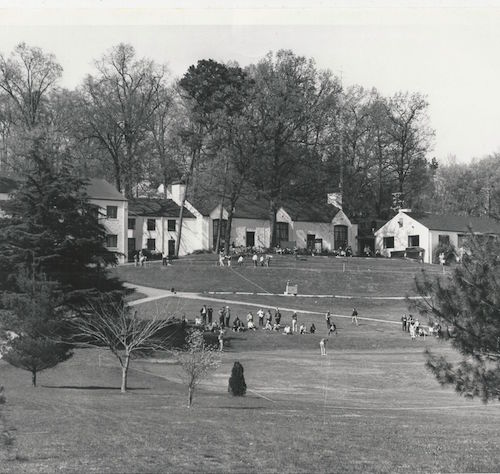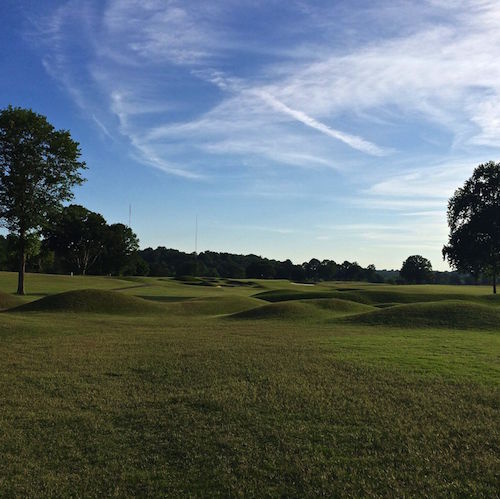
AN UNTOUCHED ROSS DESIGN
“It immediately reminded me of Shinnecock Hills,” McConnell recalls, referencing the storied eastern Long Island golf club that was a founding member of the USGA and next year will host its fifth U.S. Open Championship.
Acclaimed golf course architect Tom Doak says that of all the Ross-designed courses, Holston Hills comes closest to his original design. This year, Golf Digest ranked the dutifully preserved 1927 course No. 4 in Tennessee, while also including it in its top-100 classic courses nationwide.
“It has some of the best bunker complexes that I have seen on any Ross course,” says McConnell. “I knew when I saw Holston Hills that it would be a great addition to our golf portfolio. It’s a must-play for our members.”
The co-founder of the Donald Ross Society, Michael J. Fay, has said that he would rather play Holston Hills on a consistent basis than any other golf course in the South. If the vision of Ross, horse, and cart culpting the course isn’t enough to give you goosebumps, there are plenty more magical elements to the course. It was here Bryon Nelson won the Knoxville Invitational in 1945, one of his 18 PGA TOUR victories that year.
THE HOUSE ON THE HILL
McConnell Golf purchased Holston Hills in December 2015 and — with a nod to the past and an eye on the future — immediately started to bring renowned architect Charles Barber’s building back to its glory days.
From its hilltop perch, nearly every hole of the golf course is visible, and the clubhouse takes every advantage to show off the view inside with oversized windows. The most popular outdoor area is undoubtedly the new second-story veranda off the Donald Ross dining room, while an original terrace on the south side of the ballroom also offers space to enjoy the view.
Opposite these transfixing vistas, the clubhouse offers subtle hints to its fascinating past. Just to the west of the front entrance, between a row of cypress trees, an unseen door hides in plain sight. And just to the right of the southwest ballroom entrance, exterior steps lead to a seemingly inconspicuous basement door. Except, it doesn’t lead to a basement, per se.
“Decades ago, there was reason to need a secret way to exit the club and make your way back into the neighborhood,” explains clubhouse manager Jim Disney. “The clubhouse was actually built with tunnels and hidden exits from different rooms for this purpose.”
Though all other remnants are now sealed off for safety, one part of the “escape route” is still in use. A wide passage way runs the full length of the terrace and is currently used for storage.
Another historical nugget that’s often overlooked hangs in the southeast entryway of the Donald Ross dining room. Archie Campbell, long-time member and celebrity of Hee Haw and Grand Ole Opry fame, painted the course and clubhouse landscape in the ‘70s. (Yes, he painted!) These limited-edition paintings were sold to raise money for the club’s west wing, which now houses the Holston Room, fitness center, locker room, and kids’ room.
A NEW ERA
Bringing a 90-year-old building (and its additions) up to modern times is no small task, but it’s one that McConnell Golf is pleased to unveil. After $1.4 million in capital improvements, Holston Hills now joins its sister properties and “clubs of the future.”
Last year, McConnell Golf added a fitness center and members have since enjoyed extended hours via key fob access seven days a week, giving them the flexibility to customize their workout routines.
The former kitchen was completely gutted; an entirely new restaurant opened called the Donald Ross Room. The room includes a bar, high-top and booth seating, and an outdoor veranda overlooking the 18th hole. It’s where everyone goes after a round.
The club upgraded the Holston Room for private dining and business meetings. This room has maintained the original arched ceilings and offers a stunning view of the course. The men’s locker room underwent a nice facelift as well. One hundred wooden lockers were added, along with a bathroom and card room remodel. The grand ballroom retained its original 1920s feel with wood beam ceilings, but has added new flooring and windows overlooking the terrace on the golf course side of the club with a great view of the Smoky Mountains. This room seats 250-270 for weddings and events.
A relocated golf shop on the east side of the building offers the most current lines in apparel along with the club room that houses fitting carts and all equipment. Members can now enjoy the new portico when arriving at the club. “It also makes the arrival for golf much more service friendly when using the new bag drop area,” says Chris Dibble, director of golf.
And for the kids? The former golf shop has been converted to a dedicated Kids’ Club area with tons of activities. Since last winter, Holston Hills has hosted a monthly, staff-led kids’ program with activities that range from outdoor games to arts and crafts.
The club also added its first summer camps this year, allowing kids to take advantage of all the club’s facilities — from learning golf and tennis fundamentals, to cooling off at the pool.
Adjacent to the pool, the tennis facility has four Rubico clay tennis courts and two hard courts. The courts are professionally maintained and enjoyed during peak season from April through November, with hard courts remaining in play during the off-season as well.
Beyond open play, the club’s growing tennis program features seasonal clinics led by tennis pros Bart Kennedy and Troy Cash. The multi-day clinics help players of all levels sharpen their skills and master the strategy of the doubles or singles format.
“The impact of all these improvements around the club has been tremendous,” says Brian Donaldson, a Holston Hills member since 1988. “One of the many attractions of becoming part of McConnell Golf is
their devotion to family. I am seeing a lot of new faces around the club in the demographic that private clubs have to draw from, which is younger families.”
McConnell sums it up well: “Holston Hills enjoys a proud past and we think that it has a great future as well.”
